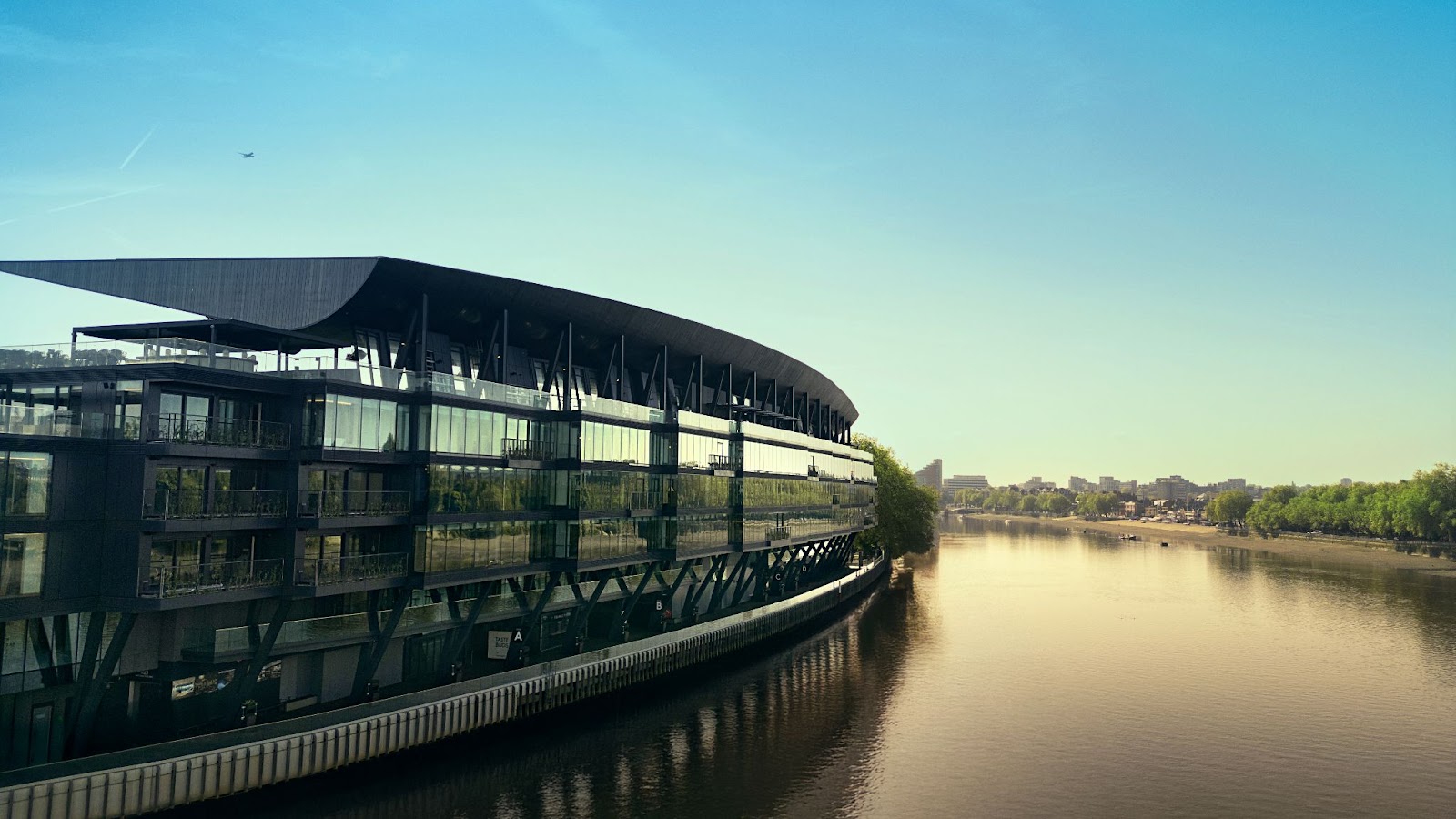Kieran Timberlake’s solemn US embassy in London captures the stability of the republic but not the vibrancy of its people, finds Larry Malcic

The new 12-storey, 48,000-square-metre American Embassy in London is generating widespread interest and comment, not least from the President of the United States who has chosen to vocally express his disdain for the project, and refused to attend its opening ceremony. His critique has been terse and emphatic; yet it has nothing to do with the architecture (rather, his objection was to the cost and the location south of the river, at Nine Elms). But his reservations point to a fundamental challenge of embassy design; the building is judged as much for the values it is meant to represent, as for its intrinsic merit as an architectural object. An embassy is laden with symbolism and is meant to project and promote the vision and virtues of its home country.
Kieran Timberlake, the Philadelphia-based architect whose design won an architectural competition for the embassy in 2010, is acutely aware of this. James Timberlake has written that “the expressive challenge for this embassy was to give form to the core beliefs of our democracy – transparency, openness and equality – yet do so in a way that was secure and environmentally responsible”.
The architect’s brief, running to 1,000 pages, demanded that “the building will reflect the values and spirit of the American people”. Eight years later, the building is complete and its success can be judged, on its own terms and perhaps also in comparison with the previous American embassy in Grosvenor Square, designed by Eero Saarinen.
Gone is sunny optimism, the brash theatricality of golden eagles, the self-assured conviction of modernism. In its place, a building of earnestness, solemnity and self-effacing simplicity”
The ability to compare and contrast sharpens focus and heightens judgment. Saarinen’s building, opened in 1960, is a gem of mid-century modernism that celebrated and encapsulated America’s position in a post-war world; fresh, confident, boldly chiselled, crisp, innovative and modern. Though deferential in height and massing to its Mayfair neighbours, it is unashamedly contemporary in its cantilevers, its glazed piano nobile, diagrid structure and precast concrete elevations. Saarinen wanted his architecture to reflect and embody “new structural material, new uses, a new spirit of our age”. This confident spirit of American optimism and expansionism is summed up in the outspread wings of Theodore Roszak’s 11-metre gold-anodised aluminium eagle that surmounts the Grosvenor Square facade.
Location plan. A civic plaza forms part of a pedestrian greenway extending from Vauxhall in the east to Battersea in the west. The embassy building accommodates 800 staff and is expected to receive 1000 daily visitors.
Nearly six decades later, the world, and the United States, have evolved and the new American Embassy in Nine Elms aptly reflects many of those changes. Gone is sunny optimism, the brash theatricality of golden eagles, the self-assured conviction of modernism. In its place, a building of earnestness, solemnity and self-effacing simplicity; high quality in materials and intellectual intent but a statement of America taking a step back from the world stage. Starting with the basic geometry of a cube, the new building is stolid; while the hurly-burly of a newly transformed and invigorated neighbourhood bustles around it, the embassy sits composed, elegant and remote from its surroundings.
Part of this sense of separation rests with the legal requirement for extensive security setbacks from the property line, but the geometry itself expresses a self-contained isolation. As Timberlake says, “the cube is not a designed form – it is selected, and beyond invention. As a pure geometry, the cube is an ancient signifier of solidity, strength, and permanence”. True enough, but it is also self-referential and incapable of growth or change.
The cube sits on a four-sided colonnade, added to evoke democracy, but unusable as a traditional arcade because the narrow space between the columns and the glazing allows no room for passage.
Translucent ETFE shading to the triple-glazed, thermally broken curtain walls among a raft of sustainability measures that also includes a solar photovoltaic array, ground-source heat pumps, demand-controlled ventilation and daylight dimming and reduced lighting power densities.
Much comment has attached to the pond, or reflecting pool, adjacent to the building. This feature – an integral part of the landscape plan – retains rainwater on the site, prevents pollution from flowing into local waterways and naturally irrigates the surrounding landscape. It also forms a barrier and security line for the embassy (though as it does not fully encircle the building, technically it is not a moat).
The formality and finishes speak firmly of American strength, wealth and position; quotations engraved in the stone convey uplifting, if obvious, sentiments”
The building is entirely clad in laminated glass, with solar shading on the east, west and south. The ‘translucent, crystalline cube’ is said to illustrate core democratic values of transparency, openness and equality. By that measure a significant number of general office buildings are equally statements of democratic intent. The floor-to-floor glazing provides excellent natural light deep into the plan, enhancing the work environment, and the outer screen of stretched ETFE serves as a shading device and sculptural enhancement of the glass cube. Presumably for security reasons, the structure supporting this gossamer veil is elephantine, creating a curious visual distraction from the often striking views offered from within the building.
Just as the building sits proudly central in its landscaped park, landscaped gardens spiral upwards within the building. These double-height gardens, some internal and others external, offer break-out spaces and connecting stairs, providing alternatives to the lifts and respite from the offices. The garden themes – Desert Canyons, Gulf Coast, Midwest Prairie, Potomac River Valley, Pacific Forest and Mid-Atlantic – are intended to reflect the diversity of American topography, and do introduce variety and identity to the spaces, but simultaneously dilute the absolute strength of the clever diagram by implying a need to decorate or theme areas of the building.
These pleasant, attractive gardens provide social spaces for the large, generally open-plan office floors. The workspaces have high ceilings, with a 4.5-metre floor-to-floor, and feel generous and open. The arrangement of the floors allows daylight and views deep into the space, often into the lift lobbies at the heart of the plan. With 15-metre core-to-glass spans, the organisation of the building is remarkably flexible, and should be adaptable over time.
At the ground floor three distinct entry points are created: a formal main entry for official visitors and staff; a consular entry to receive visitors seeking passports and visas; and a service entry for maintenance and deliveries.
The main and consular entrances are impressive and generous, with elegant stone walls and floors, and bespoke art integrated into the design. There is the obligatory grand staircase for receptions, and a dramatic glass bridge linking the two sides of the building. The formality and finishes speak firmly of American strength, wealth and position; quotations engraved in the stone convey uplifting, if obvious, sentiments. It is a rich environment without ostentation. It offers plenty of gravitas, but lacks the sleek, slender grace of Saarinen’s version.
The building’s primary public spaces include a ground floor consular lobby leading to waiting areas on the first and second levels, each overlooking the pond and the Thames to the north.
The new American Embassy is very worthy. It is exceptionally sustainable, with the design targeting ratings of BREEAM Outstanding, LEED Platinum and EPC A+, and is on track to be net carbon neutral. It has undoubtedly served as a catalyst for the long overdue regeneration of Nine Elms. It is adding handsome, accessible park areas to the community, helping to form a new linear landscape zone connecting Vauxhall to Battersea. The offices are well-lit, well planned and largely column-free, encouraging collaborative working and allowing for future flexibility. It offers visitors and staff space, comfort, light and security while conveying America’s position in the world. But does it reflect the values and spirit of the American people?
It has been said that America is a turbulent society but a stable republic. Kieran Timberlake and its team of consultants has captured the stability, but not necessarily the turbulence or exuberance of the American people. Everything demanded by the 1,000-page brief is there – well mannered, thoughtfully conceived and intellectually justified – but worthiness is not the same as greatness. The embassy is the product of ten years’ work and one billion dollars; a dash of wit, or emotion, or humanity might have added zest to this otherwise fine, thoughtful and well-crafted home away from home for America.
Additional Images
Credits
Architect
Kieran Timberlake
Interior workplace design
Gensler
Structural and security engineer
Thornton Tomasetti
MEP, civil, facade and sustainability engineer
Arup
Landscape
Olin
Costs
Aecom
Technical security design
Sako & Associates
US lead contractor
BL Harbert International
UK lead contractor
Sir Robert McAlpine
Client
US Department of State, Bureau of Overseas Buildings Operations































